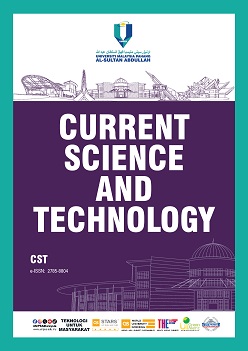Development of Cylindrical Cavity Resonator Technique for Magnetic Loss Measurement in Yttrium Iron Garnet
DOI:
https://doi.org/10.15282/cst.v4i1.11557Keywords:
Cylindrical cavity resonator, Transmission loss, C-band frequency, Yttrium iron garnet, Microwave ceramicsAbstract
Cavity resonators are essential as high-sensitivity sensors, capable of detecting small changes in electromagnetic fields or material properties, owing to their ability to generate strong fields at resonance. However, due to budget constraints limiting access to advanced technology, developing a custom-built cavity resonator can be a more cost-effective alternative to purchasing commercially available resonators. Building on this motivation, a cylindrical cavity resonator was designed and fabricated specifically for microwave loss measurement, focusing on C-band frequencies. The performance of the fabricated resonator was assessed through COMSOL simulations and experimentally validated by measuring transmission loss with a vector network analyzer connected to the resonator, where a spherical yttrium iron garnet (YIG) sample was employed as a tested material. The simulation result of the magnetic field radiation pattern validates the performance and efficacy of the fabricated cavity resonator. The S21 parameter measurements revealed a transmission loss of -62.2 dB for the empty resonator, while the YIG-filled resonator exhibited a transmission loss of -57.87 dB under 0 kOe and increased to -23.13 dB when a magnetic field of 0.5 kOe was applied. The increase in transmission loss can be attributed to the changes in the magnetic properties of YIG under the influence of the external magnetic field. This resulted in enhanced resonance conditions where coupling between EM waves and the samples leads to improved resonance conditions and reduced losses, as the alignment of magnetic moments improves the coupling between electromagnetic waves and the materials, which is associated with the ferromagnetic resonance of YIG.
References
[1] F. Heydari, S. S. Seyyed Afghahi, A. A. E. Valmoozi, and S. M. B. Bahrani, “Optimization of magnetic dielectric nanocomposites obtained by facile and low-cost fabrication for effective absorption of electromagnetic waves,” Journal of Plasma Chemistry and Plasma Processing Research, vol. 5, pp. 1-23, 2024.
[2] Y. Jiang, H. Liu, R. Muhammad, X. Luo, K. Song, M. Mao, et al., “Broadband and high-efficiency of garnet-typed ceramic dielectric resonator antenna for 5G/6G communication application,” Ceramics International, vol. 48, pp. 26922-26927, 2022.
[3] S. J. Feng, J. L. Ni, F. Hu, X. C. Kan, Q. R. Li, Y. J. Yang, et al., “Reduction of hysteresis loss in soft magnetic composites under transverse magnetic field,” Applied Physics Letters, vol. 117, p. 122402, 2020.
[4] Y. Yang, H. Zhang, J. Li, Y. Rao, G. Wang, and G. Gan, “Bi3+ doping-adjusted microstructure, magnetic, and dielectric properties of nickel zinc ferrite ceramics for high frequency LTCC antennas,” Ceramics International, vol. 46, pp. 25697-25704, 2020.
[5] R. A. Ribas, I. E. Gelosi, A. J. Uriz, J. C. Moreira, and J. C. Bonadero, “A high sensitivity cylindrical cavity resonator sensor for the characterization of aqueous solutions,” IEEE Sensors Journal, vol. 21, pp. 7581-7589, 2021.
[6] S. Campione, I. C. Reines, L. K. Warne, C. Grimms, J. T. Williams, R. K. Gutierrez, et al., “Perturbation theory to model shielding effectiveness of cavities loaded with electromagnetic dampeners,” Electronic Letters, vol. 55, pp. 644-646, 2019.
[7] J. Krupka, B. Salski, P. Kopyt, and W. Gwarek, “Electrodynamic study of YIG filters and resonators,” Scientific Reports, vol. 6, pp. 34739, 2016.
[8] A. P. Read, B.J. Chapman, C.U. Lei, J.C. Curtis, S. Ganjam, L. Krayzman, et al., “Precision measurement of the microwave dielectric loss of saphire in the quantum regime with parts-per-billion sensitivity,” Physical Review Applied, vol. 19, p. 034064, 2023.
[9] S. Mondal, and S. K. Biswas, “A novel technique to measure small dielectric losses using cylindrical cavity resonator at X-band,” Journal of Microwave Power and Electromagnetic Energy, vol. 49, pp. 207-214, 2015.
[10] R. Nazlan, M. Hashim, I. Ismail, R. S. Azis, J. Hassan, Z. Abbas, et al., “Compositional and frequency dependent-magnetic and microwave characteristics of indium substituted yttrium iron garnet,” Journal of Materials Science: Materials in Electronics, vol. 28, pp. 3029-3041, 2017.
[11] S. Jiang, L. Sun, Y. Yin, Y. Fu, C. Luo, Y. Zhai, et al., “Ferromagnetic resonance linewidth and two-magnon scattering in Fe1-xGdx thin films,” AIP Advances, vol. 7, p. 056029, 2017.
[12] J. C. Aphesteguy, A. Damiani, D. Di Giovanni, and S. E. Jacobo, “Microwave absorption behaviour of a polyaniline magnetic composite in the X-band,” Physica B, vol. 407, pp. 3168-3171, 2012.
[13] S. Dobak, C. Beatrice, V. Tsakaloudi, and F. Fiorillo, “Magnetic losses in soft ferrites,” Magnetochemistry, vol. 8, p. 60, 2022.
[14] F. N. Shafiee, R. S. Azis, N. H. Abdullah, M. S. Mustaffa, R. Nazlan, I. Ismail et al., “Potential patch antenna application with particle size variation in polycrystalline gadolinium iron garnet (GdIG), Journal of the Australian Ceramic Society, vol. 56, pp 1097-1105, 2020.
[15] X. Wu, S. Yam W. Liu, Z. Feng, Y. Chen, and V.G. Harris, “Influence of particle size on the magnetic spectrum of NiCuZn ferrites for electromagnetic shielding applications,” Journal of Magnetism and Magnetic Materials, vol. 401, pp. 1093-1096, 2016.
[16] G. V. Kurlyandskaya, S. M. Bhagat, S. E. Jacobo, J. C. Aphesteguy, and N. N. Schegoleva, “Microwave resonant and zero-field absorption study of pure and doped ferrite nanoparticles,” Journal of Physics and Chemistry Solids, vol. 72, pp. 276-285, 2011.
[17] R. Nazlan, I. Ismail, R. S. Azis, Z. Abbas, I. R. Ibrahim, F. M. Idris, et al., “Dependence of magnetic and microwave loss on evolving microstructure in yttrium iron garnet,” Journal of Materials Science: Materials in Electronics, vol. 29, pp. 8688-8700, 2018.
[18] M. S. Sikder, M. D. Hossain, I. Sardar, M. S. Hossain, M. N. I. Khan, and M. R. Rahman, “Improved magnetic and dielectric quality factors with low losses in rare earth (Eu) substituted Co-Ni-Zn ferrites for high frequency devices,” Results in Physics, vol. 46, p. 106320, 2023.
[19] P. Maltoni, S. A. Ivanov, G. Barucca, G. Varvaro, D. Peddis, and R. Mathieu, “Complex correlations between microstructure and magnetic behavior in SrFe12O19 hexaferrite nanoparticles,” Scientific Reports, vol. 11, p. 23307, 2021.
[20] D.M. Pozar, Microwave Engineering, 4th ed., New York: John Wiley & Sons, pp. 274, 2012.
Downloads
Published
Issue
Section
License
Copyright (c) 2024 The Author(s)

This work is licensed under a Creative Commons Attribution-NonCommercial 4.0 International License.



